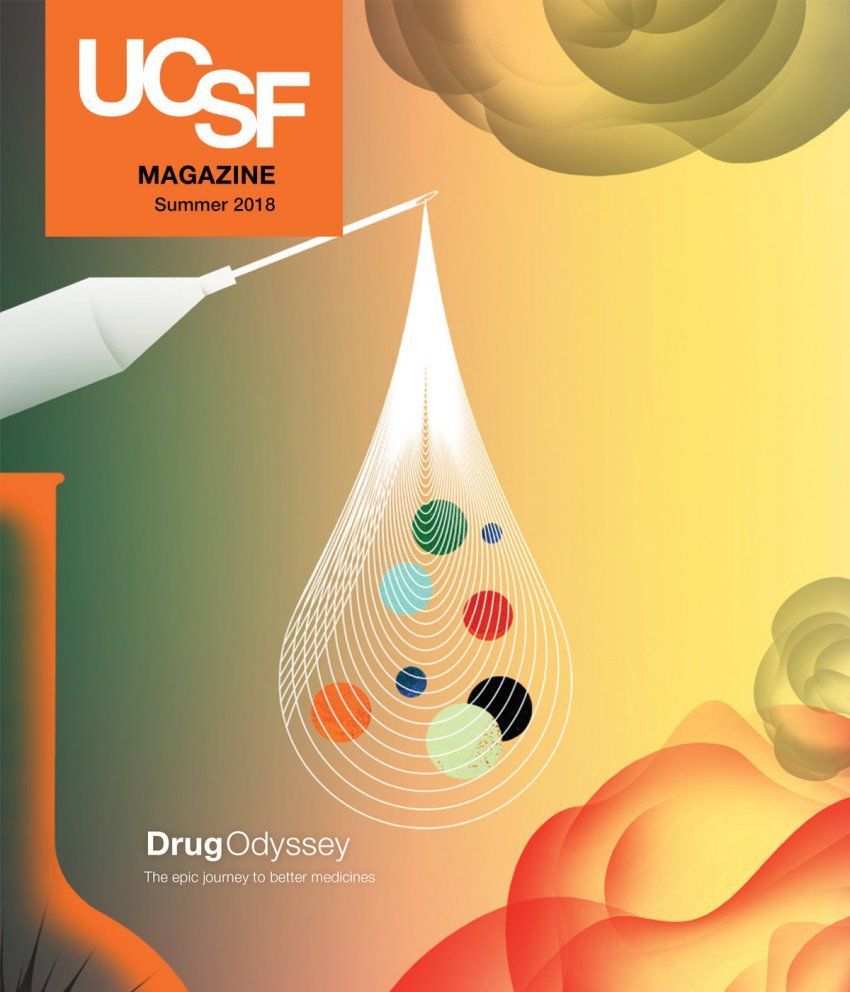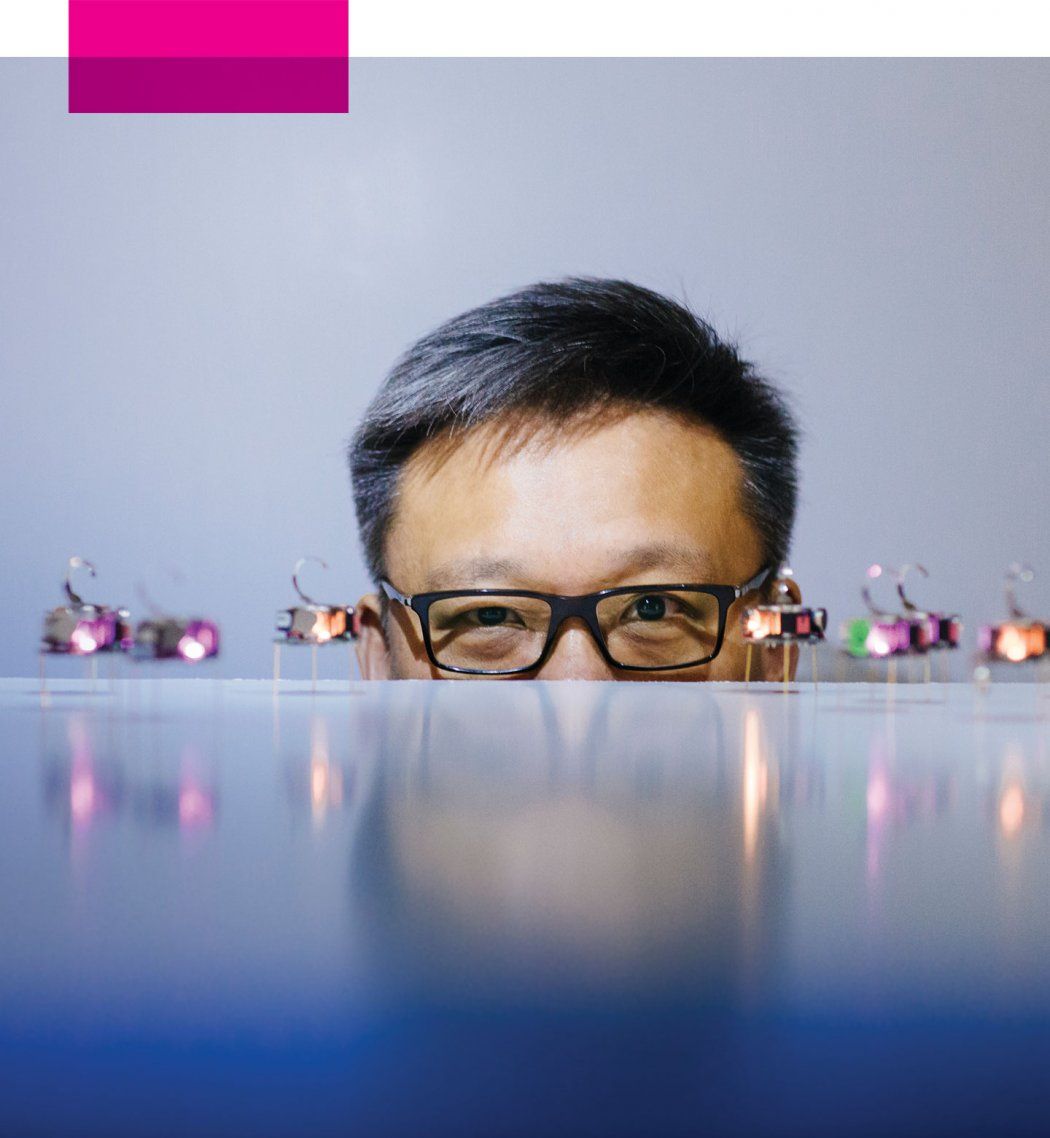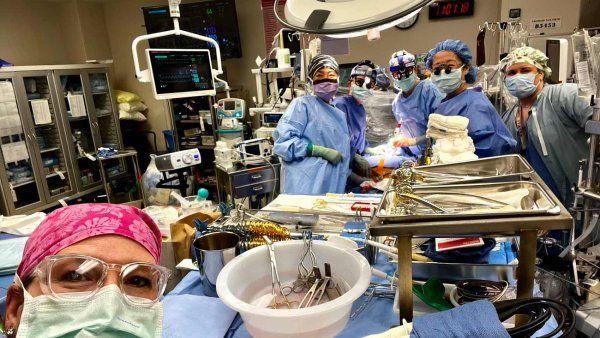Scientists working on the molecular and cellular level know that big things happen in small systems.
In 2007, UCSF’s Kevan Shokat, PhD, parlayed his work on kinases – enzymes that regulate cellular pathways – into a company, Intellikine, which developed small-molecule drugs to fight cancer. Four years later, Takeda Pharmaceuticals of Japan acquired Intellikine for $190 million, boosting the odds that Shokat’s discoveries would make it into approved therapies that would reach patients.
When you experience that kind of success, colleagues take notice. So, it turns out, do their spouses.
Wendell Lim, PhD – like Shokat, one of the leading lights in UCSF’s Department of Cellular and Molecular Pharmacology – felt a little heat when his wife, Karen Earle, MD, heard the news of Shokat’s success.
“That’s really cool,” she said. “You should do that.”
Lim laughed, he recalls. “My work is not like that,” he told her, explaining that “Kevan is a chemist – a chemical biologist who develops small-molecule drugs.” It’s much more common for someone like that to have industry take their work and apply it to patients.
Lim saw himself differently. He’s a basic scientist. He’s not finding cures or designing drugs. He’s following his curiosity. He’s pushing the frontiers of human knowledge. If anything, he’s a scientist with a passion for art – someone who nearly chose an artist’s life and still loves to paint, draw, and make prints and who brings creativity to his work in the lab.
Well, he was strictly a basic scientist, until his work started revealing a translational side. That knowledge he’s uncovering? It might save lives, it turns out. As Lim pressed on with his study of the science of cells, seeking to understand their secret programming language – the way they send and receive signals to control all the important things happening in the human body – he started to take his insights to the next level. He figured if he knew how cells were programmed, then perhaps he could reprogram them. He even developed ways to create new synthetic cells, which he believed could act like tiny robots inside the body, aiding the immune system as it fights cancer cells.
That, it turned out, was an idea the biotech industry could get behind.
In 2014, the University, Lim, and several of his postdocs and other colleagues patented some of the discoveries from his lab. Venture capitalists and others began lining up to fund the creation of a company almost immediately. In 2015, Lim teamed up with a blue-chip group of investors to establish Cell Design Labs (CDL), which raised $34 million in venture capital. In what industry observers say was a head-spinning turn of events, biotech giant Gilead Sciences acquired CDL in December 2017 in a deal worth at least $175 million – and as much as $567 million if certain milestones are met.
While Earle believed in Lim’s scientific abilities, she hadn’t been seriously prodding him to follow in Shokat’s footsteps. And her offhand comment didn’t cause Lim to pursue translational medicine and start a company. He and his team simply followed the science, and, in this case, it led them to breakthroughs that could have a real impact for patients.
Noble Aims
Like Lim, most academic scientists who launch companies or license their work to the private sector are motivated by far more than the potential payout. Instead, they understand that companies have the resources and expertise to get drugs, therapies, technologies, and other solutions out of the lab and into the marketplace, where they can help patients. Companies can raise money; navigate the regulatory process; fund expensive, late-stage clinical trials; and bring products to market.
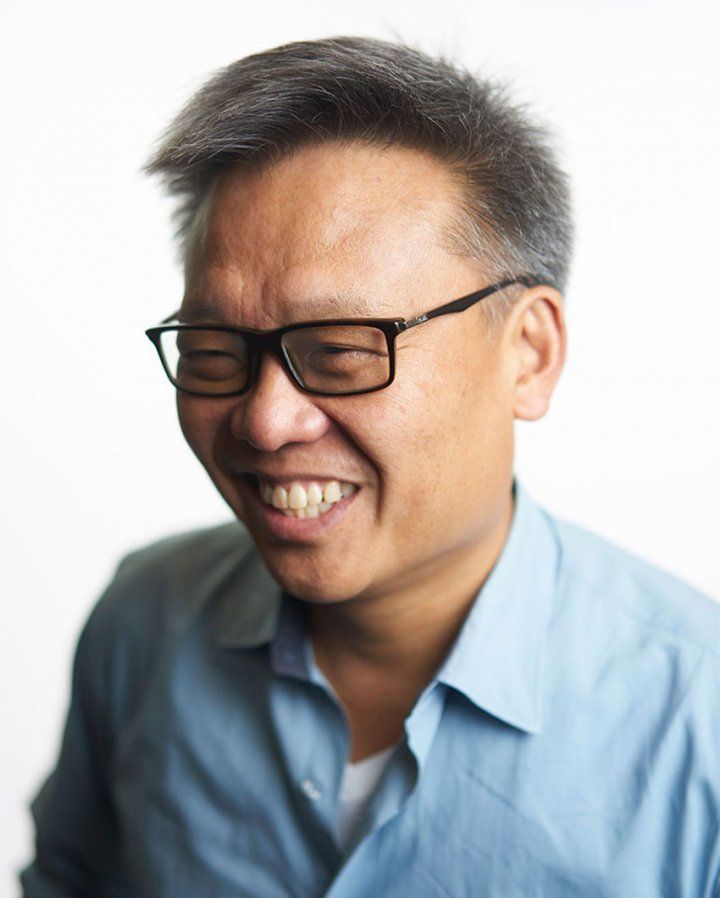
Wendell Lim is UCSF’s Byers Distinguished Professor. Photo: Steve Babuljak
“University labs excel in basic chemistry and biology, but the task of testing potential drugs in humans – or otherwise demonstrating proof of concept and building real value – falls to industry,” says Harold “Barry” Selick, PhD, UCSF’s vice chancellor for business development, innovation, and partnerships.
Biotech and pharmaceutical companies increasingly look to academia for groundbreaking discoveries that could fuel their next big advance in patient care. In the Bay Area, where venture capitalists mint millionaires, and tiny tech startups turn into $1 billion unicorns, creative people with great ideas frequently become successful startup entrepreneurs – and health sciences professors are no exception.
Lim is only the latest of a number of UCSF scientists who have turned the intellectual property developed in their labs into companies that became hot acquisitions. In 2017, UCSF scientists logged 233 new inventions, received 56 newly issued U.S. patents, started 13 new companies, produced 97 technology licenses, and generated $25.2 million in licensing income for the University.
But even in the context of those numbers, the speed at which Lim’s work moved from idea to company to buyout was dizzying, especially considering the size of the deal. In many ways, that deal helps validate a big bet UCSF is making: that an ambitious internal investment program will help its scientists develop and bring their discoveries to patients quickly. In 2017, Selick, a former UCSF postdoc, returned to the University after a successful career in biotech. He now runs UCSF’s newly created Innovation Ventures, a broad initiative designed to encourage scientists to build greater value in their programs before partnering with industry or starting a company.
Rock Star
Lim, who succeeded Shokat as chair of the Department of Cellular and Molecular Pharmacology (and, like Shokat, is an investigator with the prestigious Howard Hughes Medical Institute), has described his work as ripped from the pages of science fiction.
Selick was at a meeting of academic and industry leaders where Lim was a featured speaker, holding the group in thrall. “The guy’s a rock star,” Selick says. “The way he thinks about engineering cells is the way anyone else thinks about building with Legos.”
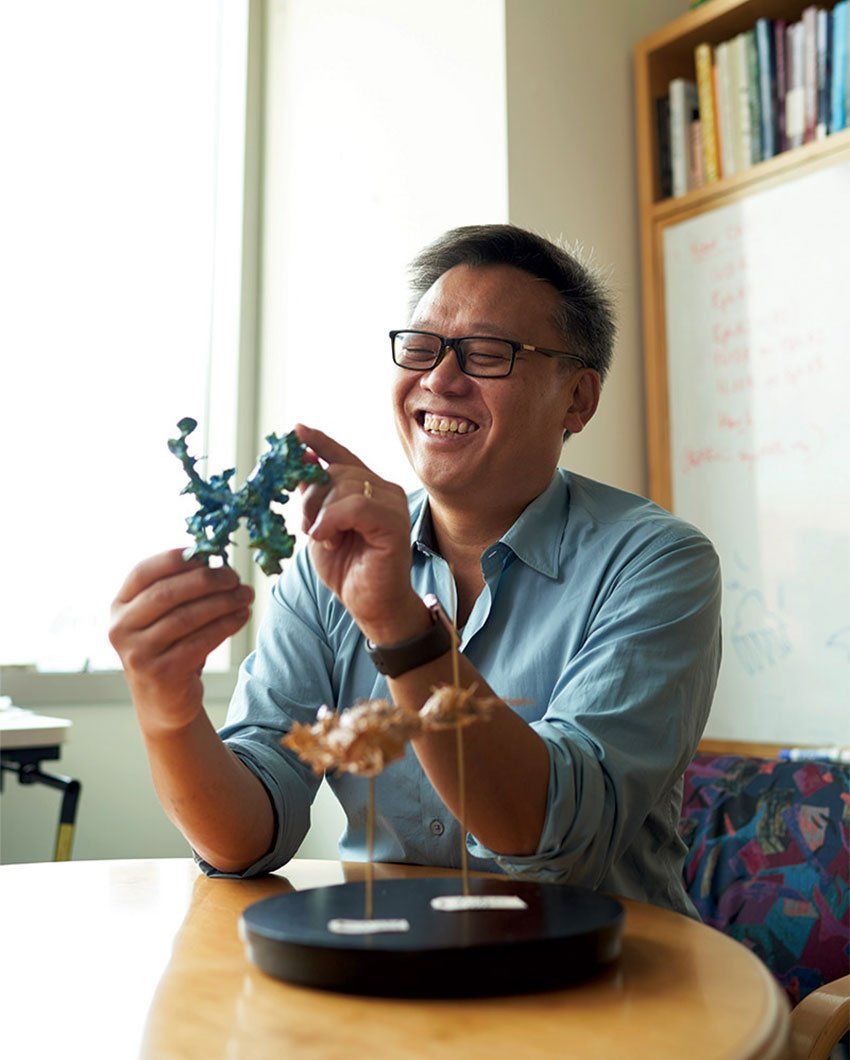
Lim, who once thought about pursuing art as a career, brings a creativity to his work as a scientist. Photo: Steve Babuljak
Lim, who is also the Byers Distinguished Professor, holds several patents; his lab helped develop CRISPRi, CRISPRa, and other pioneering genetic technologies. These advances took CRISPR, which has been called “the world’s most versatile gene-editing tool” and one of the most exciting biological discoveries of the past decade, and enabled scientists to do more than merely edit genes – now they could control them. CRISPRi allows for “interference,” or switching genes off; CRISPRa allows for “activation,” or turning them on.
Taking that project to the next level, Lim started creating customized cells that scientists can program. He began looking at T cells, immune system components that attack harmful invaders.
Doctors have been experimenting with using patients’ own immune cells to treat their cancer. The most promising results so far have come when scientists engineer chimeric antigen receptor (CAR) T cells to attack certain blood cancers. So Lim and his team set out to gain more control over CAR T cells, in the hope that they would tackle solid tumors. They tried using small-molecule drugs to harness CAR T cells’ power, hoping to avoid potentially lethal side effects.
At the same time, Lim set an even more audacious goal: to find a solution beyond drugs. “Really, our dream is to have cells that are like natural cells,” he says. “Natural cells don’t need to be told what to do. They’re very smart. They’re like autonomous vehicles. They can look at lots of situations and know what to do.”
In Lim’s dream, an autonomous cell would attack cancerous antigens without attacking healthy cells.
To get there, Lim and his collaborators – including one of his former postdocs, Kole Roybal, PhD, who is now on the UCSF faculty and who won the Sartorius & Science Prize for this work – first developed “on-switch” technology, which can control when therapeutic proteins are activated, or switched on. Then they had another breakthrough, devising something they called synNotch receptors, which, according to an online forum run by the publication Ars Technica, “might well be the next great revolution in cancer therapy.”
The term synNotch is shorthand for “synthetic notch,” with notch being a specific cell surface receptor – a protein that plays a key role in enabling cells to communicate with other building blocks of the body, such as hormones, nutrients, and neurotransmitters. Synthetic means it was made in the lab – part of Lim’s goal of creating cells to do specific tasks.
SynNotch receptors represent one of the key technological underpinnings of Cell Design Labs.
Birth of a Business
When a scientist makes an important technological advance, as Lim did, that’s considered intellectual property – much like a novel produced by an author. But such intellectual property is not protected until the scientist files a patent; without that protection, anyone else could use the knowledge to devise their own therapy. Potential investors want to see a patent before putting their money behind an idea. UCSF has an office of experts to help scientists navigate the world of patent law.
Todd Pazdera, PhD, is associate director of UCSF’s Office of Technology Management (OTM) – part of Selick’s newly revamped Innovation Ventures organization. Pazdera is a scientist by training whose career took a turn toward business shortly after he received his PhD in biological sciences from Carnegie Mellon University.
“I love the interface between science and business,” he says. “Startup development and licensing create a mechanism to translate the science into new products.”
That’s where OTM comes in. “We say, ‘Let’s talk about where we can go next,’” Pazdera explains. “‘Let’s think about how to advance the science to the next stage toward commercialization.’”
Selick says Pazdera played a critical role in getting Cell Design Labs off the ground and eventually sold to Gilead.
What’s fun for me now is realizing just how much creativity is required in science. Whenever you put together a piece of work, it’s really a big canvas.
Pazdera has been involved in launching many University startups, and he already had a good relationship with Lim. When Lim’s experiments in synthetic biology began to bear fruit with the development of synNotch, the conversations expanded.
Lim’s work was much further out on the cutting edge than most of what Pazdera sees. “We’re doing such new stuff that there’s not a lot of appreciation for what its value is,” Lim says. “We’re creating what its value is.”
It’s so new that Lim eventually had to fly to Washington, DC, with a lawyer to educate patent examiners about the technology. The patents were filed in 2014, and then came the next decision: Should they start a company? License the technology?
“Many companies were interested in the technology, including several venture capitalists,” says Pazdera, who reviewed the business plans that many of them had submitted.
Some of the bidders wanted to license the technology. Scientists often see an advantage to licensing, in that a company will have the resources to move the technology forward and the scientist can stay in academia, without the headache of running a company. But scientists often worry, if they license their innovation, whether they’ll lose control of it. Will its new owner have the same drive to champion the technology as its creator?
Lim had another concern, because his technology was so new and complex: “If people didn’t understand it, would they really push it and keep developing it?”
“That,” he says, “is where the idea came from that we really need to start our own company.”
Given the Bay Area’s entrepreneurial ecosystem, Lim’s work quickly attracted investors and $34.4 million in financing. In June 2016, Cell Design Labs set up shop at an incubator just south of UCSF’s Mission Bay campus.
One critically important early investor was Kite Pharma, which was doing similar work with therapeutic cells. Kite, a publicly traded company headquartered just west of Los Angeles, in Santa Monica, not only invested in CDL but also established a research collaboration with the newly formed company.
Unleashing Entrepreneurs
When Harold “Barry” Selick, PhD, arrived at UCSF in the newly created post of vice chancellor for business development, innovation, and partnerships, he thought he’d have to ferret out researchers whose projects might have commercial potential. To his surprise, the researchers started finding him.
“For every faculty member I went to, four or five came to me,” Selick says. “There is so much pent-up interest in entrepreneurship here, it’s almost unbelievable.”
Of course, scientists have been starting companies out of UCSF since 1976, when biochemistry professor Herbert Boyer, PhD, teamed up with venture capitalist Robert Swanson to start Genentech, launching the biotech industry. Shortly thereafter, in 1981, Chiron Pharmaceuticals was founded by three UC academics, led by William Rutter, PhD, the Herzstein Professor emeritus at UCSF.
Selick, who completed a postdoctoral fellowship at UCSF at the start of his career, was a beneficiary of that trend. He started out as a successful bench scientist, worked his way into the executive suite, and ultimately co-founded and ran two companies himself, including Threshold Pharmaceuticals, an oncology drug discovery company that he led as CEO from its founding, through its initial public offering, to its sale in 2017.
Now that he’s returned to academia, he waxes enthusiastic about the prospects of starting even more companies, finding the sweet spot that both helps patients and generates substantial returns for the University.
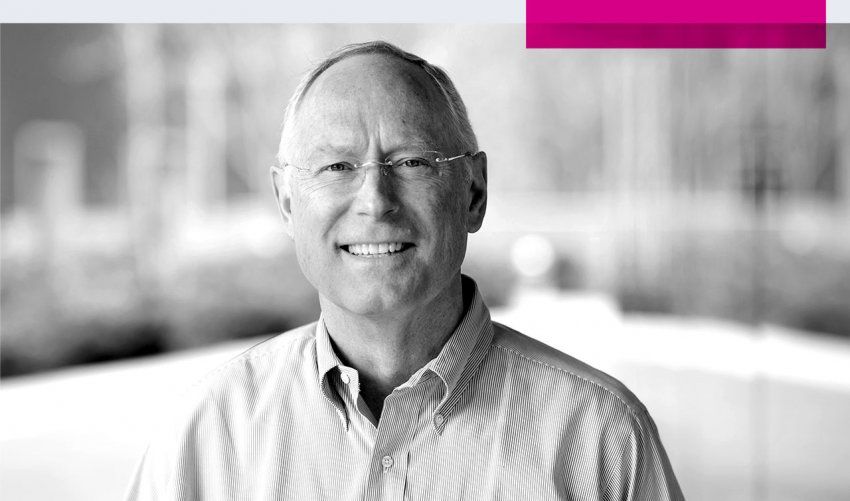
Barry Selick is a UCSF postdoc alum. Photo: Noah Berger
“When I did my postdoc here in the ’80s, entrepreneurship was almost a bad word,” Selick says. Many people viewed industry with suspicion. Now, he says, “that sentiment has almost flipped.”
Innovation Ventures aims to accelerate the process of bringing discoveries to patients, in the process helping UCSF achieve its mission of transforming health care.
In the words of Regis Kelly, PhD, director of QB3, the Institute for Quantitative Biosciences on UCSF’s Mission Bay campus: “It’s a big goal: Make UCSF the premier life sciences entrepreneurship campus in the country.”
Moving Fast
Within six months of its founding, CDL moved to Emeryville, across the bay from San Francisco. In its first two years, the company grew to 70 people.
Then, in August 2017, Gilead Sciences – founded and headquartered in the Bay Area and one of the world’s largest biotech companies – bought Kite for $11.9 billion. Kite’s founder and CEO, Arie Belldegrun, MD, a highly regarded industry veteran, was close to CDL’s leadership, Pazdera says.
“Kite knew Cell Design Labs very well and appreciated the power of the technology, and they convinced Gilead to get interested, and that’s how the sale happened,” Lim says.
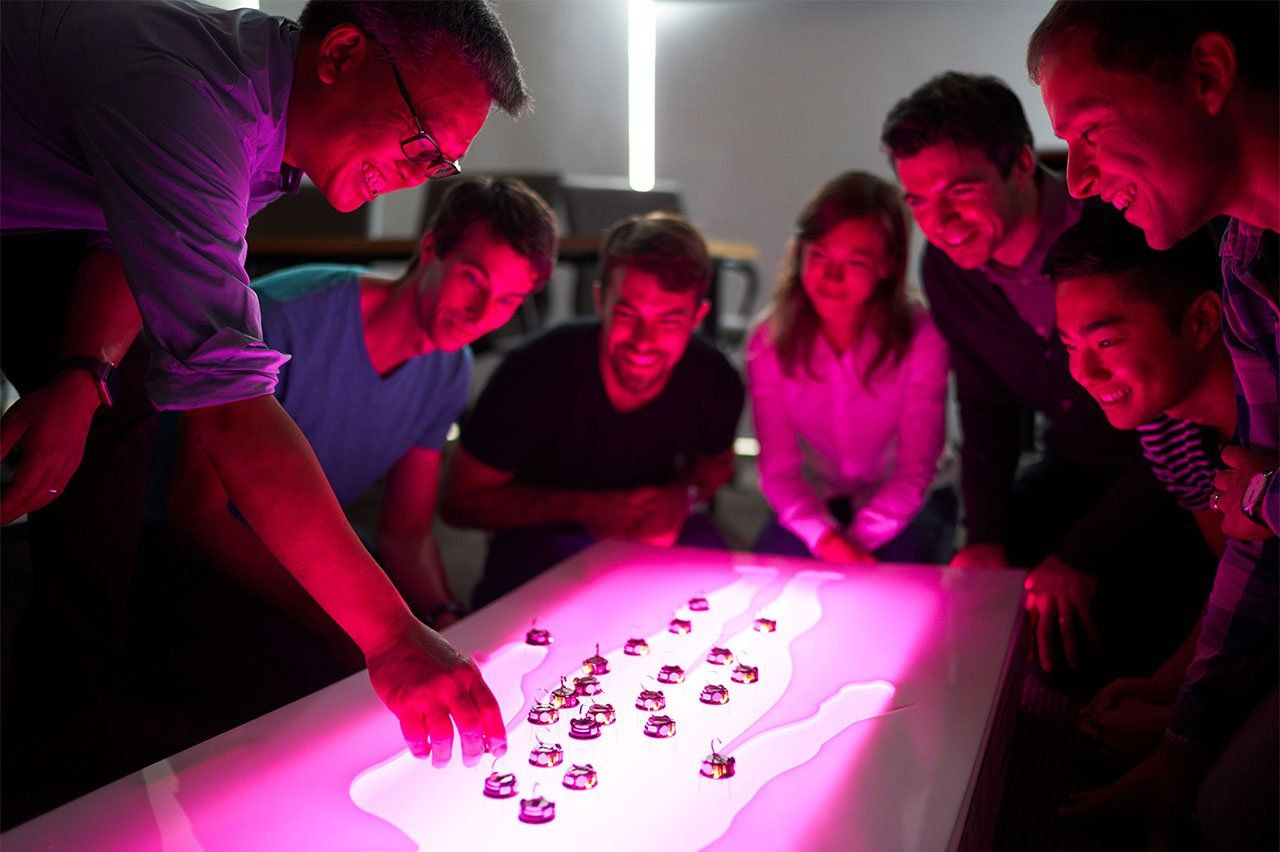
Lim engages with students in his lab. Photo: Steve Babuljak
The deal – which went from filing a patent in December 2014 to establishing a startup in December 2015 to an acquisition in December 2017 – was one of the quickest Pazdera has seen in his 15 years in the field.
It helped that the field of immuno-oncology, or using the immune system to attack cancer, is particularly hot right now. But perhaps most important was the scientist behind the technology. Lim’s hands-on involvement showed investors that this was “real-deal, cream-of-the-crop stuff,” Pazdera says. And when Gilead showed an interest, Lim played a major role in educating them about the company and the potential of its technology.
Even after the sale, Lim continues to work as an adviser to Cell Design Labs, and he keeps pushing the work forward in his own lab at UCSF.
An Artist, Too
When Lim was a high school student in Chicago, he was already showing an aptitude for science. The son of physician-scientists at the University of Chicago, Lim was a Westinghouse Science Talent Search finalist, earned degrees from Harvard and MIT, and was a postdoctoral fellow at Yale. Ever since arriving at UCSF in 1996, he has astounded the scientific community with the cellular insights and innovations emerging from his lab.
Yet since childhood, Lim has always loved art, too. He met Earle, his wife, in an art class at Yale. Even as he pursued his career in science, he never stopped creating art.
“We both have a passion for art,” Earle says. “Painting, drawing, sketching are all outlets for Wendell.”
Lim now uses his art to communicate what’s happening in the microscopic world in which he performs his science.

“People don’t understand what we do,” Lim says. “That’s a big issue. Our world’s not that different, it’s just really small. We know it, but how do we let other people know about it? I’ve been experimenting with different ways to do that.”
His lab website is chock-full of these efforts, including bright, whimsical cover art that he has had accepted by scientific journals. For one on “orchestrating cell signaling with optogenetics,” he drew a Matisse-like cellist and a Cubist guitar. For another, on “scaffold regulation of MAPK signaling,” he showed workers in hard hats at a construction site’s scaffolding, as green, blob-like molecules are hoisted into place.
His website also features some of his paintings; lately, Earle says, Lim’s abstract paintings “are almost molecular in nature.”
Lim even designed the logo for Cell Design Labs, in which small white gears engage on a field of orange, evoking neural synapses clicking into place. Such projects are one way he keeps his artistic chops alive.
“What’s fun for me now is realizing just how much creativity is required in science,” Lim says. “Whenever you put together a piece of work, it’s really a big canvas. You have to think about composition, what it means to you, what it means to other people. It’s pretty interesting. The brushes are just a lot bigger.”
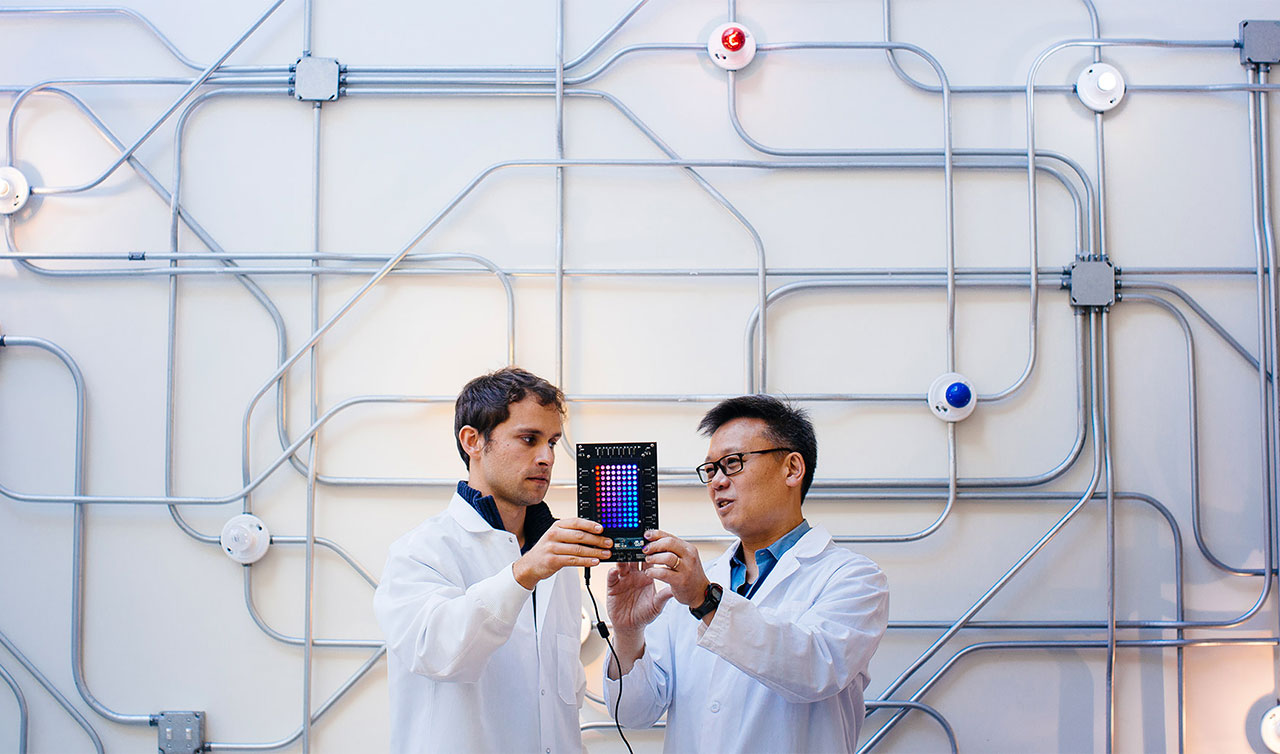
Lim confers with postdoc Lukasz Bugaj. Photo: Elena Zhukova
Successful Spin-Offs
The Office of Technology Management at UCSF has facilitated more than 100 startups, including these multimillion-dollar deals involving technology that emerged from UCSF labs in recent years:
eFFECTOR Therapeutics invents and develops small-molecule drugs to fight cancer, with a long-term goal of attacking other diseases, too. Founded in 2012 by UCSF faculty members Kevan Shokat, PhD, and Davide Ruggero, PhD, the Diller Family Professor, eFFECTOR has raised nearly $140 million in four rounds of venture capital financing.
Pliant Therapeutics develops therapies to treat fibrotic disorders of the lung, liver, and kidney. It was founded in 2016 by the UCSF research team of Dean Sheppard, MD; William DeGrado, PhD; Harold Chapman, MD; and Bradley Backes, PhD, with $45 million from Third Rock Ventures, LLC.
Pionyr Immunotherapeutics harnesses the body’s own antitumor immunity. Max Krummel, PhD, UCSF’s Smith Professor of Experimental Pathology, co-founded the company in 2015 with Sachdev Sidhu, PhD, a former Genentech protein engineer now at the University of Toronto. In December 2017, Pionyr announced a $62 million Series B round of investment.
Relievant Medsystems designs medical devices that use nerve ablation to treat chronic low back pain. Founded in 2006 by UCSF’s Jeffrey Lotz, PhD, the Bradford Professor of Orthopaedic Surgery, and Christian Diederich, PhD, a professor of radiation oncology, the company has raised more than $95 million over the years, including $36 million in equity financing in 2016.
Neurona Therapeutics applies stem cell research to the treatment of neurological diseases. Its UCSF co-founders were Arturo Alvarez-Buylla, PhD, the Muss Endowed Professor; Arnold Kriegstein, MD, PhD, the Bowes Distinguished Professor; John Rubenstein, MD, PhD, the Ireland Distinguished Professor; and Cory Nicholas, PhD ’09, an adjunct assistant professor of neurology. The company was launched in 2015, having raised more than $31 million.
Fortis Therapeutics develops new antibody drug conjugate therapies for late-stage cancers. It was founded in 2016, based on technology developed by Bin Liu, PhD, a professor of anesthesia and perioperative care, and raised $18 million in Series A financing.
